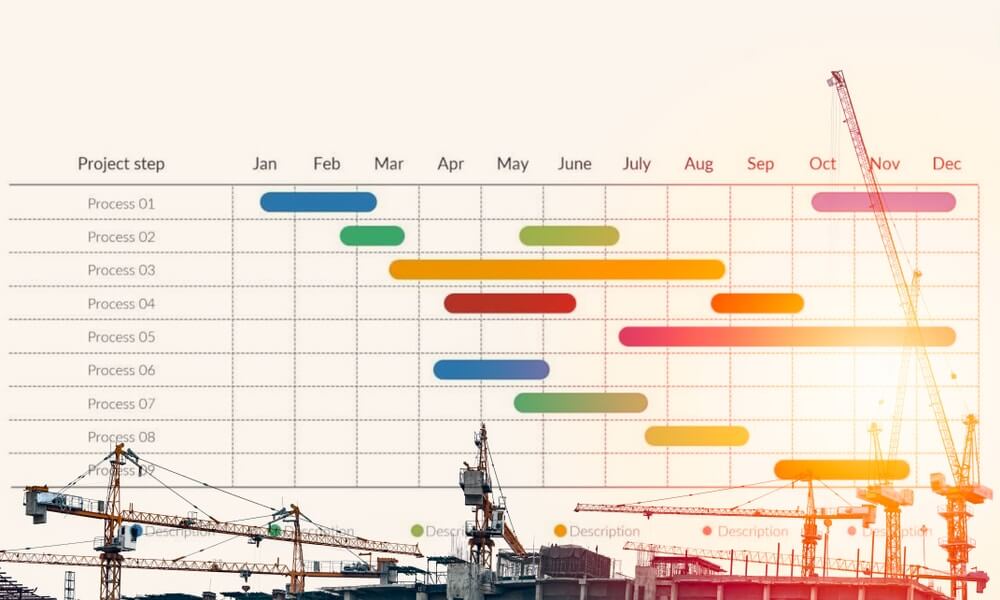“On time and on budget” is the mantra for construction. Keeping costs down is often easier than staying on schedule. Construction industry trends show that creating a construction project schedule is a key piece in the project management process and one that can set the tone for an entire project. Let’s look at how a construction schedule is created and get some insight into how this powerful tool is used.
What Is a Construction Schedule?
A construction schedule is a detailed timeline or plan outlining the sequence of activities, tasks, and events that need to be completed during the construction of a project. It serves as a roadmap for the entire construction process, providing a systematic and organized approach to managing various tasks from the beginning to the completion of the project.
What Are The Most Common Types of Schedules Used in Construction?
Several types of schedules are commonly used in construction to plan, organize, and manage the various activities involved in a project. Some of the most common types of construction schedules include:
- Gantt Charts: Gantt charts provide a visual representation of a project schedule, displaying tasks or activities along a timeline. This type of schedule is helpful for illustrating task dependencies and durations.
- Bar Charts: Bar charts, similar to Gantt charts, depict project tasks and their durations using horizontal bars. They are straightforward and easy to understand, making them useful for high-level project overviews.
- Milestone Schedules: Milestone schedules focus on key project milestones, which are significant events or achievements. This type of schedule is useful for tracking progress and ensuring that crucial project objectives are met on time.
- Network Diagrams: Network diagrams, including Critical Path Method (CPM) and Program Evaluation and Review Technique (PERT), map out the relationships and dependencies between tasks. These diagrams help identify the critical path and optimize project timelines.
What Makes a Good Construction Schedule?
A good construction schedule is a critical tool for successful project management, ensuring that the project is completed on time, within budget, and meets quality standards. Here are key characteristics that contribute to the effectiveness of a construction schedule:
Accuracy and Realism
- Accurate Estimates: Ensure that the duration and resource estimates for each task are realistic and based on historical data or industry standards.
- Realistic Timeframes: Set achievable timelines for tasks, considering factors such as weather conditions, site constraints, and unforeseen challenges.
Comprehensive Task List
- Detailed Tasks: Break down the project into detailed tasks, providing a comprehensive overview of all activities required for completion.
- Logical Sequencing: Arrange tasks in a logical order, considering dependencies and relationships between activities.
Clear Task Dependencies
- Identify Critical Path: Determine the critical path – the sequence of tasks that, if delayed, would impact the overall project timeline.
- Dependency Mapping: Clearly indicate task dependencies, including those that are finish-to-start, start-to-start, finish-to-finish, and start-to-finish.
Tips for Good Construction Scheduling
Creating and managing an effective construction schedule requires careful planning and attention to detail. Here are some tips for developing a good construction schedule:
- Start Early: Begin the scheduling process early in the project to allow for thorough planning and identification of potential challenges.
- Involve Key Stakeholders: Collaborate with project managers, contractors, subcontractors, and other key stakeholders to gather input and ensure all perspectives are considered.
- Thorough Task Identification: Break down the project into detailed tasks, making sure to include all necessary activities for a comprehensive overview.
- Understand Dependencies: Clearly identify task dependencies to ensure that the sequence of activities is logical and that delays in one task do not impact others.
What Is The Construction Scheduling Software?
Construction scheduling software is a type of project management tool designed specifically for the construction industry to plan, organize, and manage construction projects efficiently. These software solutions help in creating detailed construction schedules, tracking progress, managing resources, and facilitating communication among project stakeholders. Some popular features of construction scheduling software include Gantt charts, task dependencies, resource allocation, and reporting capabilities.
1. Know the project
The first step to creating a construction schedule is to know the project. Review the plans and specifications thoroughly, so you know what work has to be done. For example, an office may require flooring, painting, demolition, framing, and drywall.
Next, determine the sequence of work or the order in which the work must be completed. In our example, the demolition would come first, followed by the framing, drywall, painting, and flooring. Sequencing involves not only determining the order of the work but knowing what has to be completed before the next step can be taken. This creates relationships between the tasks that will determine how the work progresses.
Then you’ll need to know who will complete each activity (for example, the general contractor, a subcontractor, or the owner) and how long each activity will take. The duration of the activity can depend on several factors, including material availability, the level of manpower on the job, and the skill of the workers.
2. Create a work breakdown structure (WBS)
A work breakdown structure, or WBS, is a visual representation of all the work tasks that must be completed on a project. It’s based on the deliverables that must be provided and breaks a construction project down into its individual tasks.
A WBS separates each component of the project and breaks them down into smaller tasks. Each task is considered a work package and is provided by a single party, the general contractor, a subcontractor, or the owner.
For example, let’s break down the construction scheduling of a wall assembly. The assembly will be comprised of the following tasks:
- wood framing
- insulation
- drywall and finishing
- priming and painting
Each of these tasks is to be completed by a different contractor and is dependent on the previous task being completed before beginning work.
A WBS is used to schedule projects and determine the relationship between tasks and the order they are completed in. This information is then used to lay out the construction project schedule.
Construction Schedules are often depicted as a Gantt chart, which is a cross between a spreadsheet and a timeline.
3. Assign tasks and durations
Once the WBS is established, each task is assigned to a resource (the general contractor, subcontractor, or owner). In addition, each task is assigned a duration, or the time it will take to complete the task. If you’re unsure about how long a task will take, reach out to the subcontractor or contractor providing the work and ask them. Most subcontractors will be optimistic in their estimated durations, so it pays to add some extra time just in case.
Next, key dates for the project are marked as milestones. These dates often don’t change, even if other dates on the schedule do. Milestone dates may include equipment delivery, opening day, or other dates that might affect the construction project management or the completion of the project.
4. Connect tasks based on their predecessors and successors
When using resources like general contractor scheduling software, Related tasks on the WBS are connected via their relationship with tasks that must be completed before them (predecessors) and those that must be completed after them (successors). For example, in a wall assembly, the insulation is a predecessor for drywall because it must be installed before the drywall is hung. Priming and painting are successors to the drywall because they must be done only after the drywall is complete.
5. Review the schedule
Once the construction activities have been defined, tasks assigned, durations determined, and tasks ordered and connected by their relationship with other tasks, the project schedule is complete. It should be reviewed by the project team for accuracy and to ensure that no tasks are missed. If mistakes are found, the schedule can be changed to accommodate added work or missed tasks.
Once everyone has approved the schedule, it becomes the baseline schedule for the project.
6. Continually update and review the schedule
As the work progresses, the schedule should be reviewed and revised to reflect the actual work being performed. For instance, tasks may take longer than originally scheduled, or material may be late, causing activity to be delayed. It’s important to keep all members of the project team updated on any revisions or changes that affect their scope of work and the project’s overall schedule.
By continually reviewing and updating the project schedule, you’ll be able to identify tasks that are running ahead of schedule and pull resources, like manpower or equipment, from these tasks to help complete work that is behind schedule. Shifting resources like this helps ensure that the construction project stays on its anticipated completion schedule and looking at new trends like automation in construction.
Keeping a project on schedule often calls for foresight and imaginative thinking. Project managers who have these skills can be invaluable to the process of completing a project. PMs may use lean construction tools, like pull planning, to ensure the schedule is accurate and achievable. If you’re interested for more information about construction scheduling or scheduling software, check out Planhub, a construction bidding website, where you can expand your network, find new construction projects, and get right to work.



